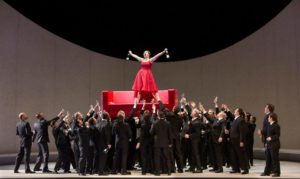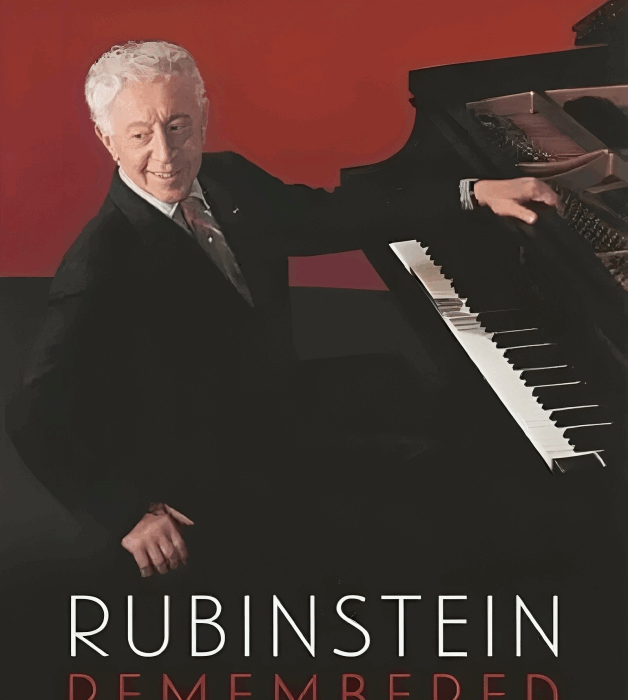
Page to Opera Stage: How Verdi Reframes a True Story & Novel in ‘La Traviata’
By Carmen Paddock(Credit: Ken Howard )
“Page to Opera Stage” looks at stories – real-life or fiction, old and new – that have inspired operas, and the ways these narratives have been edited and dramatized to fit a new medium. This week, the focus is Alexandre Dumas fils’ semi-autobiographic novel “La dame aux camelias” and Giuseppe Verdi’s operatic adaptation “La Traviata.”
The origins of “La Traviata” – arguably Giuseppe Verdi’s most recognizable opera – go back to the mythology of one remarkable, remarkably short life. There is much speculated about Marie Duplessis, Parisian courtesan and salon hostess, but the basics are known.
Born Alphonsine Plessis in 1824, she moved between her ill mother, abusive father, and various family members in her childhood and early adolescence, going to work as a laundress around the age of 11. By the age of 15, she was installed as a “kept woman” in Paris, restyling herself as Marie Duplessis and growing her admirers year on year to fund a lavish lifestyle. She learned to read so she could stay abreast of current affairs and artistic trends, winning loyalty from her lovers for her wit as much as her looks. Despite her luxury, she died penniless of “consumption” – likely tuberculosis – at the age of 23.
Between September 1844 and August 1845, she was the mistress of Alexandre Dumas fils – six months her junior and the illegitimate son of the author of “The Count of Monte Cristo,” “The Three Musketeers,” and “The Man in the Iron Mask.” The young man followed in his supportive father’s footsteps, and the publication of his third novel – “La dame aux camelias” – fictionalized his romance with Duplessis.
Renamed Marguerite Gautier and Armand Duval, the lovers had a shorter, more tumultuous affair than their real-life counterparts. While Dumas fils met Duplessis when he moved to live closer to his father in Paris, there is little real-world evidence to suggest Dumas père was as involved in his son’s life or concerned with appearances as Armand’s father is in the novel (which would have been hypocritical to the extreme considering Dumas père’s possible forty affairs and seven illegitimate children). Nevertheless, the novel captures the intensity of a passionate romance that not only
The 1848 novel was a moderate success and Dumas fils’ 1852 stage adaptation a smash hit, catching the attention of composer Giuseppe Verdi. Verdi and librettist Francesco Maria Piave – a pairing that had previously adapted work by Byron, Shakespeare, and Hugo – transformed the younger Dumas’ story into a tightly crafted character study that took cues from bel canto musical structures while looking ahead to the intimacy and psychological realism of late 19th century European opera.
In condensing a mid-length novel with its longer time period and larger cast to a three-act opera that runs just over two hours, Verdi and Piave masterfully reshape the story while not losing its atmosphere, characterizations, or core narrative beats. The duo removed the framing story and Marguerite’s former lover’s narration, instead centering the courtesan’s perspective: Violetta never leaves the stage in Acts one and three, and her absences in Act two are brief. The novel spends much time speculating on Marguerite’s motives and interpreting her actions through the male observer and love interest, while “Traviata” lets Violetta explore and explain her motivations and limitations at length.
The first and possibly most brilliant example comes at the end of Act one, when Violetta is on her own for the first time. She sings of the strangeness of the love Alfredo declared to her before deciding to abandon it for her current hedonistic life, to live for pleasure only as her time is so short. When she hears Alfredo again, her resolve is shaken in rapid coloratura passages. It is a quietly shattering portrayal of her inner conflict between love and her livelihood.
In the novel, Marguerite only speaks uninterrupted through her deathbed letters, a reunion with Armand denied by his inability to return to Paris in time. This late-stage revelation of her inner thoughts lends a different feel to the story, centring Armand’s grief and guilt over misinterpreting her actions rather than the external forces and internal desires that drove them in the first place.
Violetta’s narrative primacy somewhat reduces Armand’s persona through Alfredo, but his narration is not necessary in a staged medium. On a similar note, Violetta’s increased agency in her storytelling does not necessarily translate to a more feminist reading – both novel and opera are sympathetic to their courtesan’s societal limitations but nonetheless contrast her against the “pure” women meant to be wives. The portrayal remains complicated, imperfect, and yet humanizing.
On a technical level, the focus on the financial realities of a courtesan’s life receive far more attention in the book, to the point that the break forced by Armand’s and Alfredo’s fathers feels the lesser obstacle. This makes sense when moving mediums – the novel can spell out the expenditures and lending required to maintain Marguerite’s lifestyle whereas these would make for clunkier staged drama.
“La Traviata,” however, dramatizes the confrontation between courtesan and father that is “offstage” in the novel, making the familial conflict the key factor in Violetta’s break from Alfredo rather than a mix of practicality and fatherly disapproval. It is far stronger drama, showing both characters coming up against a worldview irreconcilable with their own.
It is interesting to note that, in Verdi and Piave’s version, one of Dumas fils’ lines describing Marguerite’s plan to move to the country, begging Armand’s trust in her and leading to eventual financial ruin, then takes a place following Violetta’s decision to separate from Alfredo at his father’s urging. In each case, “love me as I love you” is a plea – for trust in the naïve possibility of a live of love, and then for forgiveness in advance of heartbreak. Verdi foreshadows “Amami Alfredo, amami quant’io t’amo” in the prelude’s orchestral motif, letting the audience know that Violetta’s life will change when the tune is heard again.
“Do you know what I am thinking of?”
“No.”
“Of a plan that has come into my head.”
“And what is this plan?”
“I can’t tell you yet, but I can tell you what the result would be. The result would be that in a month I should be free, I should have no more debts, and we could go and spend the summer in the country.”
“And you can’t tell me by what means?”
“No, only love me as I love you, and all will succeed.”
Not all alterations were purely for dramatic purposes; Verdi initially aimed to set his opera in the present, like the novel, but to appease censors in Venice he moves his version to “c. 1700.” This remained in practice until the 1880s. Names, already changed from reality, were changed further: Marguerite became Violetta and Armand became Alfredo. The setting remained Paris. The story was retitled “La Traviata” – the fallen woman. While the 1853 premiere was far from a success – possibly due to competition from an Italian translation of Dumas fils’ play performing near La Fenice – the opera soon found a following through Verdi’s winning melodies and his rich, sympathetic portrayal of its heroine.
Marie Duplessis has had many lives since her short one: Marguerite Gautier, Violetta Valery, and over twenty separate film versions from the silent era to 2001’s “Moulin Rouge!.” It is clear audiences still connect with the heroine’s tragic struggle for love and life in an unforgiving world, and both the story and Verdi’s masterpiece will be reframed and reimagined endlessly.
Quotes from the Project Gutenberg text of “Camille (La dame aux camelias).”
Categories
Special Features

